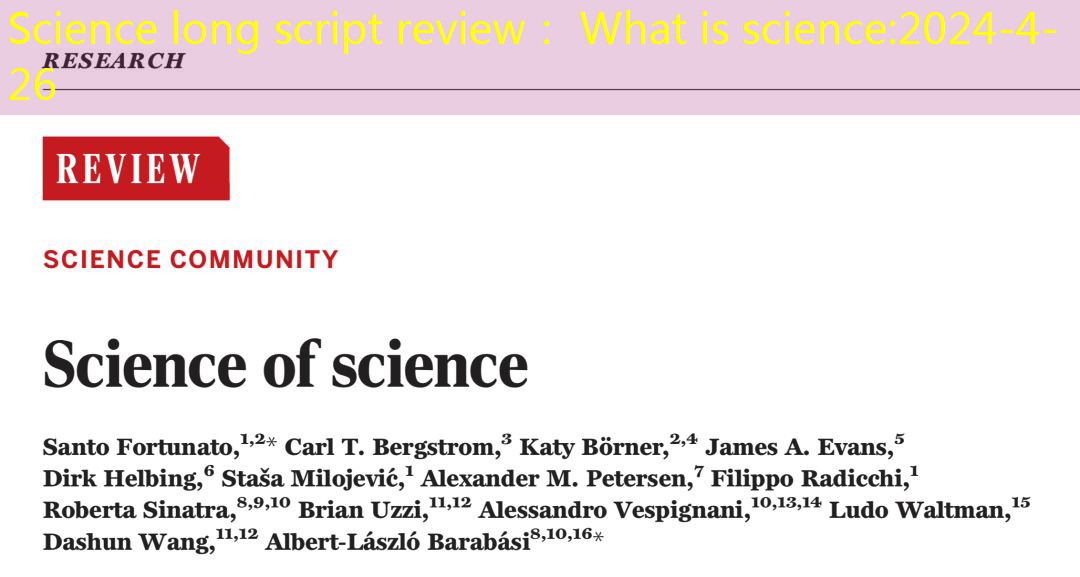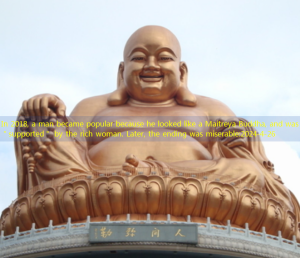Original Katy Berrner and other intellectual clubs
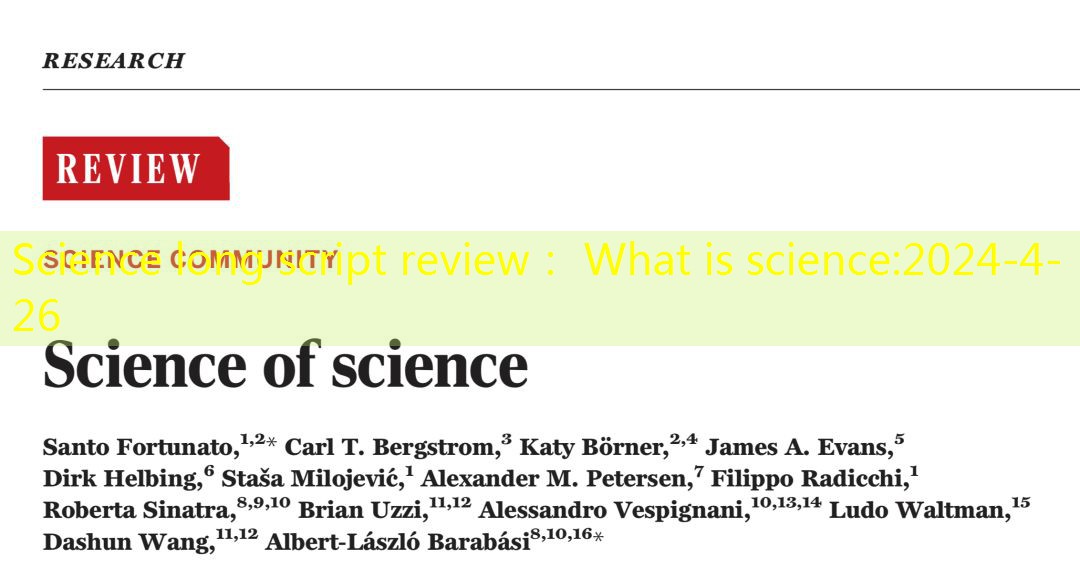
Anterior
With the advancement of science, research on citing networks, research results, and scientific policies has become increasingly concerned, and a cross -disciplinary discipline, The Science of Science, has gradually formed.In 2018, a number of scholars led by online scientists Albert-lászló Barabási, published a heavy summary on Science, which comprehensively introduced this door from the interdisciplinary methods of science and the guidance of scientific research productivity to improve scientific research productivity.”High -level discipline”.
Santo Fortunato, Carl T. BergStrom, Katy Börner, etc. | Author
Chen Xi | Translator
Cui Haochuan | Audit School
Wang Yixi, Deng Yixue | Edit
Table of contents
1. Structure abstract
1. Background
2. Progress
3. Outlook
Second, text
1. Summary
2. The network composed of scientists, scientific research institutions and scientific research ideas
3. Study the choice of problems
4. Innovation
5. The dynamics of scientists academic career
6. Team scientific research
7. The dynamics behind the reference quantity
8. Outlook
Attachment: References
1. Structure abstract
1. Background
Today, with the entire process of scientific research, including the funding of scientific research funds, academic production, scientists cooperation to the reference of the article, and the increasing number of digital acquisition capabilities of scientists, people have obtained the structure and development of scientific science and developmentUnprecedented opportunities.The Science of Science, the abbreviation of science provides a quantitative understanding of interaction between scientific and time -scale scientific and time -scale science: it allows us to understand the conditions and scientific discovery behind “creativity”.In the process, its ultimate goal is to develop a series of policies and tools that accelerate scientific research.
In the past ten years, science has attracted scientists who have research backgrounds such as nature, computers and sociology.They together built scientific research big data for empirical analysis and generating model research to capture the productivity behind science and the development and changes of practitioners.Scientific science hopes to more deeply understand and promote various factors in scientific research, so as to solve environmental, social and technical problems more effectively.
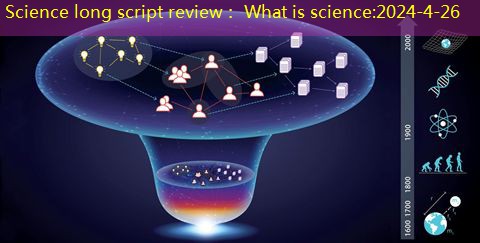
Science can be regarded as a continuous expansion and evolutionary thought, scholars and thesis network.Scientific scientific search for universal laws based on scientific structure and dynamics.
2. Progress
Science can be described as a complex, self -organized, evolving network.It consists of scholars, papers and ideas.This method of describing the problem explains many potential models, such as the research on the research of the cooperative network and the research on the reference network explains the birth of new disciplines and the birth process of major discovery.The micro -model tracks the dynamics accumulation of citations, enabling us to predict the influence of a single paper in the future.
Scientific science reveals the choices and trade -offs facing scientists on their career and scientific vision.For example, analysis shows that scholars do not like risks and are more willing to study topics related to their current professional knowledge, which limits their potential in the future.Those who are willing to break this model will engage in higher -risk occupations, but it is more likely to make major breakthroughs.
In short, the most innovative science is based on traditional discipline combinations, but this combination is often unprecedented.Finally, as the research work shifts more from individuals to teams, science science is more and more concerned about the influence and significance of the team in scientific research.Some studies have found that revolutionary ideas are usually born in small teams.In contrast, large teams tend to promote the research in cutting -edge fields, and they have a short -term influence.
3. Outlook
Science provides a quantitative understanding of the structural framework between scientists, research institutions and ideas.It helps to identify the basic mechanism behind scientific discovery.These interdisciplinary data -driven content supplements the contents of scientific measurement and related scientific and sociological areas related to science.
Although scientific thirst for long -term and universal laws and mechanisms applied to various scientific fields, first of all, it is necessary to face the unavoidable differences between culture, habits and preferences between different fields and countries.This change makes it difficult for some cross -domain insights to understand, and it is difficult to implement related scientific policies.The differences between scientific research issues and data are generally associated with the field, which also hints that in the future scientific research will have a corresponding change due to “discipline characteristics”.
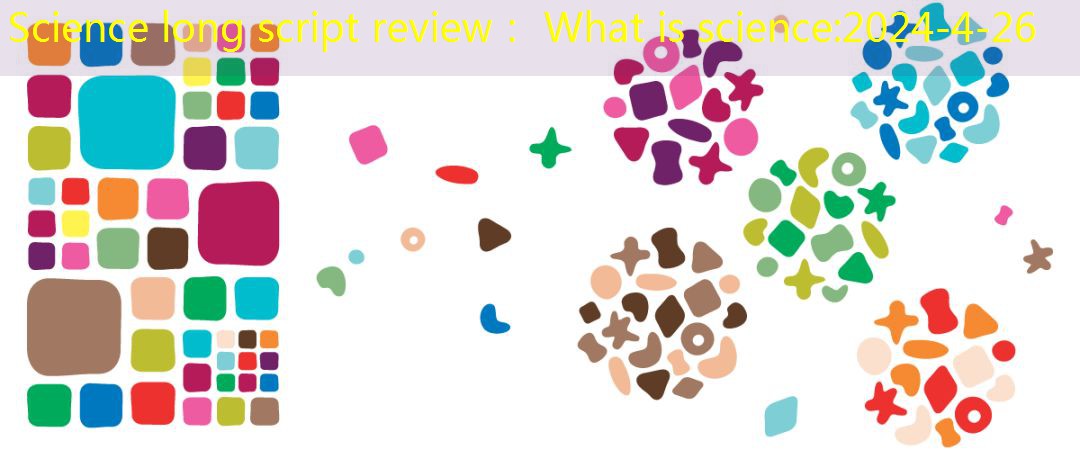
The Densification process of scientific boundaries is also a signal of interdisciplinary exploration, integration and innovation.
Second, text
1. Summary
Identify the motivation behind the development of scientific development. The model that can capture the development of science and technology can guide people to design policies to promote scientific progress.For example, by strengthening the policy design of scientists’ professional roads, better scientific performance assessment, more effective funding design, and even cutting -edge studies that will be born.Scientific science uses large -scale data on scientific production to find the laws and models of universal and specific disciplines.Here, we review the latest development of this cross -disciplinary field.
A large number of digital data about academic output provides unprecedented opportunities to explore the scientific structure and evolution model.Scientific science has placed the scientific development process under microscope, and has a quantitative understanding of the origin of scientific discovery, creativity and practice.It can develop tools and policies that accelerate scientific progress.
The emergence of science is driven by two key factors.
The first is the availability of data.In addition to the proprietary Web of Science (WOS), it is a long -established first -time attraction. Today, there are multiple data sources (Scopus, Pubmed, Google Scholar, Microsoft Academic, US Patent and Trademark Office, etc.).Some of these sources are provided free of charge, covering millions of data points related to scientists and their achievements. These data come from all walks of life and are north and south of the river.
Secondly, scientific science has benefited from nature, computing and the influx and cooperation of social scientists. They have developed data -based tools, so that key tests can run on generating models.Mechanism and driving force.
One of the highlights of this emerging field is to break the process of disciplinary boundaries. Scientific science integrates research and theory from multiple disciplines, and uses extensive data and methods.
From scientific measurement, we have learned to analyze and measure large -scale data sets; from scientific sociology, it has learned some theoretical concepts and social processes; from innovative research, it explores the ways of scientific discovery to invention and economic change.Essence
Scientific science relies on the integration of extensive quantitative methods, from descriptive statistics and data visualization to high -level econometric methods, network science methods, machine learning algorithms, mathematical analysis, and computer simulation, including subject -based modeling methods (Agent-based modeling).
The value of science is based on such a assumption: with the in -depth understanding of the factors behind successful scientific breakthroughs, and grasping the scientific research progress as a whole, thereby solving social problems more effectively.
2. The network composed of scientists, scientific research institutions and ideas
Contemporary science is a power system driven by the complex interaction between the social structure and knowledge representation and the complex interaction between the natural world.Scientific knowledge is composed of the concepts and relationships in artificial products in research papers, books, patents, software, and other academic fields.These contents are classified into disciplines and broader areas according to the tension.These societies, concepts and material elements are connected to the flow of information, ideas, scientific research, tools and case information through formal information, ideas, scientific research practices, tools, and case information.
Therefore, science can be described as a complex, self -organized, and developing multi -scale network (Multiscal Network).
Early studies have found that the number of scientific literature is accumulated with time (2) over time (2). On average 15 years, the number of literatures will double (Figure 1).However, don’t think that scientific thoughts have increased with the number of literatures.The technology and economy of the publishing industry has also improved over time, and the efficiency of publishing articles has also improved.In addition, new published articles in science often gather in different knowledge areas (3).
Researchers use large -scale text analysis to measure the awareness of scientific literature using phrases extracted from title and abstract.They found that the scope of scientific concepts expanded linearly over time.In other words, although the number of articles is exponentially increased, the new concept is increased by linearity over time, as shown in Figure 1.(4)

Figure 1 The growth of science.(A) Edit the annual output and time in the WOS database.(B) The growth of new scientific discoveries covered by literature indexed in WOS.This is determined by calculating the number of concepts in a fixed number of articles (4).
Words and phrases commonly used in the article and abstract spread through the citation network to form a model, and this model will be replaced by new paradigms in a certain time and space (5).Through the application of network science methods to the citation network for research, researchers can identify the community corresponding to the publishing articles (6) by publishing articles that are frequently quoted.These communities usually correspond to the author group (7) who hold a common position on specific problems or practitioners (8) who work on the same special scientific topic.Recently, an article concerned about the science of biomedical science illustrates how the growth of the publishing object has strengthened the “discipline community” (9).
Once the new thesis is published, the association between scientists, drugs, diseases and methods (“these things”, that is, nodes in network analysis), (that is, Hyperedge in network analysis)Update and strengthen.Most newly established links are only one or two steps away from each other, which means that when scientists choose new research topics, they prefer to choose directly related to the current professional knowledge or their professional knowledge.This densification shows that the existing scientific structure may limit future people’s research content.
The densification process of scientific boundaries is also a signal of interdisciplinary exploration, integration and innovation.
Analysis of the life cycle of eight research areas (10) shows that the successful field of success has gone through the process of knowledge and social unity, which leads to a huge channel in the collaborative network (104).EssenceA scientist has successfully reproduced the author’s productivity, the number of authors of each discipline and the interdisciplinary of the author (11) on the mathematical model of the cooperative network on the cooperation network (11).
3. Study the choice of problems
How do scientists decide what research issues?Scientific sociologists have long speculated that these options are determined by intense games between traditional research and innovation (12, 13).Scientists who adhere to the traditional research of traditional research will usually promote the process of focusing on the topic of gravity by publishing a series of stable and continuous research results, which appears to be effective.
However, too much focusing on a certain issue may limit the ability of researchers to perceive and seize the opportunity.These opportunities can find new ideas that promote the development of the field.For example, a study study of a study of biomedicists choosing a new type of chemical and existing chemical drugs has shown that with the maturity of the research field, more and more researchers pay attention to existing knowledge (3).
Although innovative articles often have a greater impact than conservative articles, high -risk and high -innovation strategies are rare, because additional rewards cannot make up for the risk of failure.Reward and honor seem to be able to take it for the main incentives of conservative tendencies. They can break the tradition and give people new surprises.Although there are many factors that affect the work of scientists, the macro model that controls the changes in research interests in scientific undertakings is obviously traceable, and these laws are hidden in the professional path of scientific research and scientists.(14).
The choice of scientists on research topics mainly affect their personal career and the career of those who rely on them.However, the decision -making of scientists’ groups sometimes work more in the direction of deciding scientific discovery (Figure 2).Research strategy conservative means that (15) Personal occupation has a stable and good prospect, but the promotion effect of the entire discipline is poor.The phenomenon of this strategy is enlarged by the phenomenon of File Drawer Privem (16): The results of inconsistent assumptions that have been established are rarely published, resulting in systemic prejudice that has been published.The untenable and false content is sometimes even regarded as a classic (17).
File drawer question:
Refers to the prejudice of the researcher’s choice of reference, and the literature that is not consistent with the study will stay in the drawer instead of taking it out as a reference.
More bold assumptions may have been tested by several generations of scientists, but only those who have successfully produced articles can be known to us.One way to solve this conservative trap problem is to urge funding agencies to actively sponsor the risk projects that test new assumptions and let special interest groups bear research on special diseases.
The results of quantitative analysis show that the distribution of American biomedical resources is related to historical allocation and research, not related to the severity of the actual problems of the disease (18), which pointed out the systemic dislocation between biomedical needs and resources.This misunderstanding makes people suspect that the funding agency will affect the development of scientific development without additional supervision, inspiration and feedback, and how much these funds run by embedded habits can affect the development of science.
4. Innovation
Analysis of articles and patents jointly proves that rare combinations in scientific discovery and inventions tend to obtain higher reference rates (3).Interdisciplinary research is an iconic process of reorganization (19); therefore, the combination of unrelated ideas and resources in history is critical to cross -disciplinary research, often anti -intuition, and leads to high influence new ideas (20).However, from the evidence applied for the fund, in the face of the real novel (21-23) or interdisciplinary (24) research issues, expert assessment systems usually give lower scores.
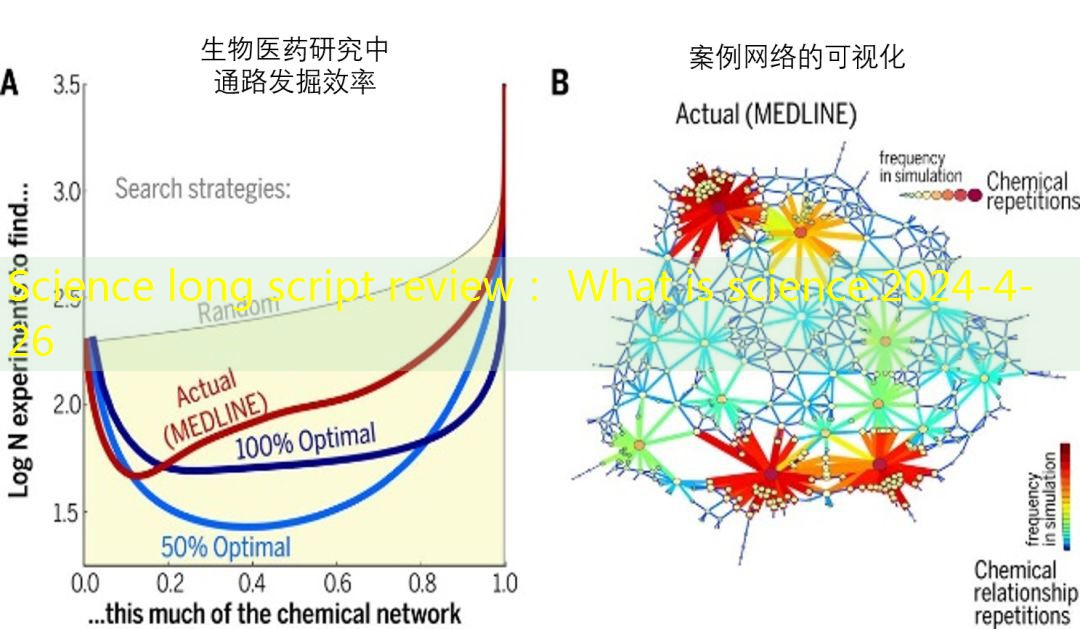
Figure 2 Select the experiment that accelerates collective discovery.
(A.) A study measured the efficiency of all new drugs published in MEDLINE (medical database) in 2010.This model does not consider the differences or costs of specific experiments.The efficiency chart of this global scientific strategy reflects the relationship between the newly published new biochemical pathway (horizontal axis) and the average number of experiments (vertical axis).Correspondingly, the network diagram between drugs can be made.Researchers use various hypothetical strategy efficiency to compare with the strategic efficiency of the actual situation, and use completely random and 50 % and 100 % to discover optimization strategies for the best network.The lower value on the vertical axis represents a more effective strategy, and the new discovery mode is not the best.The actual strategy is most suitable for discovering 13 % of the chemical network, and the 50 % optimization strategy is effective for discovering 50 % of the chemical network, but neither of them is as good as that the best strategy of 100 % of the entire network is as good.
(B) The real Chinese drug found that the network can be drawn into a chart form.The new connection of this strategy is based on some “important”, highly related chemicals, as shown in the hotspot in the figure, but the 100%efficiency research strategy shows more uniform discovery laws, and it is unlikely to be unlikely”Congzang” in the space of science possibilities.(15)
The most influential scientific work comes from the combination of conventional content, but it also comes from unusual combinations (25-27).The possibility of a high reference rate of this type of papers is twice (26).In other words, new and existing elements are the safest ways of successful scientific progress.
5. The dynamics of scientists academic career
In the background of knowledge production and use, various academic occupations have appeared (28).Therefore, scientific professional performance is not only studied for personal incentives and marginal productivity (relative gain and energy) (29), but also tested in the background of institutional incentives (30,31) and competition (32).Personal, geographical, and time large metadata crying (33) of individuals, geography and time with high content resolution are required to build a occupational trajectory that can be analyzed from different angles.For example, a study found that the funding plan for tolerated early failure (long -term success) is more likely to produce an influential publishing article (31) than the funding of the short -term review cycle.
The competitive interaction system with time scale is a classic issue in the science of complex systems.Scientific polynoma is the driving force for generating models, which can highlight the accidents of the policy.For example, the career development model shows that short -term contracts are important reasons for productivity fluctuations, because this usually leads to the sudden end of a certain cause.
The differences between productivity and occupational length can explain the differences between the cooperation mode (38) and the recruitment rate (35) between male and female scientists.On the other hand, the verification evidence shows that the prejudice of women occurred in the early stage of the career stage.When gender is randomly assigned in a group of applicants, the recruitment committee systematically despise the results of female candidates (40).
So far, most studies are concentrated on relatively small samples, improve and compile large -scale scientists data sets, and use different sources of information (for example, publishing records, appropriation applications and rewards), which will help to understand more deeply to understandReasons for inequality.Establish a motivation model that can provide information for policy solutions.
The liquidity of scientists is one of the other important factors to provide multiple professional opportunities.Most research on talent liquidity is concentrated in the influx and outflow of talents in quantitative countries or regions (41,42). This research especially occurs after policy changes.However, there are still few research on personal liquidity and their occupation, mainly because it is difficult to obtain the longitudinal information on the migration of scientists and the reasons behind the flow decision.
According to the quantity of the article, it is found that the scientists who have left the country’s country are better than those who have not left, and they perform better in the quotation of the article.This may stem from a choice preference: good scholars (capable of going abroad) are easy to get better positions (stronger teams).(43, 44).In addition, scientists tend to move between fame -to -fame institutions (45).However, when quantitative scientists are used to quantify the impact of hopping, no system is found to increase or decrease, even if scientists have moved to a quite high or low -level institution (46).In other words, it is not an institution but an individual researcher of the institution that has an impact.
Another potential factor affecting occupations is reputation, and it has two dilemma brought about by the review of literature, assessment proposals and decisions for starting points.The author’s reputation can significantly increase the number of references (47) in the first few years after the publication of the papers (47) with its previous total reference volume.However, after this initial stage, it affects the acceptance of the scientific community on work.The work of this discovery (46) shows that for the effective scientific cause, reputation is not the first productive forces, hard work, talent and difficulty in learning is the driving factor.
One question related to policy is whether creativity and innovation are related to age or career.For decades of research on outstanding researchers and innovators, major breakthroughs occurred in a relatively earlier stage in their careers, among which 35 years old (48).
However, the recent work shows that the tendency of sufficient records of early occupations was explained by the tendency of productivity. Productivity was high in the early stages of scientists’ career, and later declined (49).In other words, there is no age mode in innovation: the most cited papers for scholars can be him or any of her papers, which has nothing to do with the age or career stage at the time of the paper (Figure 3).The random model describing influence development also shows that breakthroughs are generated by the combination of scientists’ ability and selection of high potential intuition intuition and luck (49).
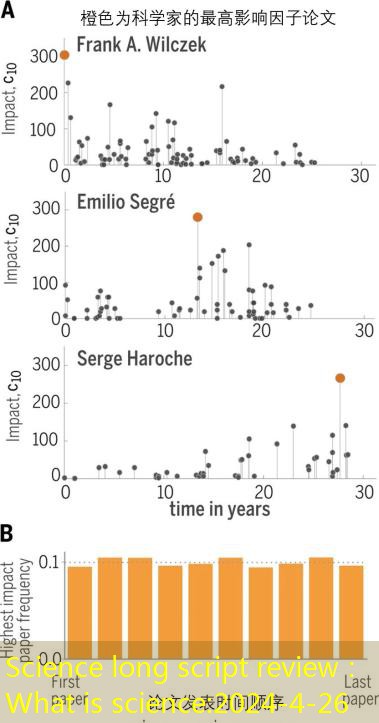
Figure 3 The impact of science science on scientific occupation
(A) The record of the winner of the three Nobel Prize in Physics.The horizontal axis indicates the number of years after the winner published the article for the first time. Each circle corresponds to a research paper. The influence of the height C10 of the circle means the number of references after 10 years.The highest influence thesis of the winners is represented by an orange circle.
(B) The histogram of the thesis that occurred in the scientist’s thesis sequence was calculated by 10,000 scientists.The flatness of the histogram shows that in the sequence of papers published by scientists, the most influential work may have the same probability (49)
6. Team scientific research
For decades, the degree of dependence of scientific research on team cooperation has increased day by day, which represents the fundamental transformation of scientific research methods.A study of the 19.9 million research papers and 2.1 million patents found a team -oriented trend in the field of scientific research (50) (Figure 4).For example, in 1955, the scientific and engineering team wrote the same number of papers as a single author.However, by 2013, the proportion of papers written by the team increased to 90 % (51).
Today, the papers written in the scientific and engineering team are 6.3 times that they may get a reference of more than 1,000, or the reference to individual dissertations. This phenomenon cannot be explained by self-citations (50,52).One possible reason is that the team can propose more novel ideas (26) or the resources that other researchers can use (for example, genomics).
The data shows that the team may have 38%more than the authors that may combine the content of scientific research breakthrough into the familiar field of knowledge, which proves that the team can combine different majors together, thereby effectively promoting the breakthrough of science.Having more collaboration means that through more common authors to improve the visibility between scholars, they may introduce each other’s work into the internal network of scientific research. This enhancement means that each researcher must share with colleagues to share with colleagues.Reputation (29).

Figure 4 The scale and influence of the team
In the past century, the average team scale has been steadily expanding.The red dotted line represents the average number of the Communist Party of China and the authors of the Communist Party of China; the black curve considers the average size of the articles with the average number of references than the field.The black curve system is located above the red dotted line, which means that large teams are more likely to have high influence work than small teams.Each chart corresponds to a disciplinary category (A) science and engineering specified in WOS, (B) social science, (C) art and humanities.
On average, researchers from large teams can get more citations in various fields.Studies have shown that small teams tend to use new ideas and opportunities to change science and technology, while large teams promote the process of existing research (53).Therefore, it is important to fund and cultivate a team of various sizes to ease science (28).
At the same time, the team size is also changing at a rate of 17 % per ten years (50, 54, 105).The scientific team includes small, stable “core” teams and large teams, and dynamic expansion teams (55).The increasing size of most fields is generated by the continuous expansion of the dynamic expansion team. The expansion team started from a small core team, but then attracted new members through the original accumulation of productivity.The scale is the key decisive factor of the team’s survival strategy: if the small team maintains a stable core, their survival time will be longer, but the large team shows a member mobile mechanism to survive for longer (56).
With the acceleration of science and increasingly complexity, the tools required to expand knowledge are increasingly improved in terms of scale and accuracy.For most individual investigators, the value of research tools is too high and there is no market, but the same is true for most institutions.Academic cooperation has always been a key solution to solve this problem, so that resources can be concentrated on scientific research.
The large -scale strong collision machine of the European Nuclear Research Center is the largest and most powerful particle collision machine in the world. Her birth cannot ignore academic cooperation. More than 10,000 scientists and engineers from more than 100 countries participated in this pairThe establishment of impact.However, as the scale increases, the value and risk related to the “big science” are immediately generated (2).Although it can solve larger problems, scientific repetitive issues require you to repeat the experiment, which may be actually inevitable or economical.
Cooperators will have a huge impact on science.According to the recent research (57,58), scientists who have lost star collaborators will experience a sharp decline in productivity, especially if the scattered partner is an ordinary researcher.The average number of references with strong collaborators will increase by 17 %, which indicates the value of professional cooperation (59).
In view of the increasing number of authors in the research papers, who should have the most reputation?The classic theory of the wrong distribution of reputation in science is the Matthew effect (60). Among them, scientists participating in cooperative work have exceeded their reputation due to their contributions.It is difficult to allocate credibility for collaborative participants, because it cannot be easily distinguished from personal contribution (61).However, it is possible to check the common mode of the common author’s paper to determine the reputation distributed by each co -author in the group (62).
7. The dynamics behind the reference quantity
Academic references are still the mainstream ways to measure academic achievements in science.Given the long-term dependencies of mainstream reference standards (63-66), the dynamic law accumulated by citations has been verified by generations of scholars.According to PRICE (67) pioneering research, the distribution of scientific papers citations is highly oriented: many papers have never been cited, but the pioneering papers can accumulate 10,000 or more references.This uneven citation distribution is a powerful, natural, and innovative attributes of scientific changes.When the paper is grouped by the agency, it is also established (68).And if the number of references of a paper is divided by the average citation of the classmate department in the same year, the score distribution obtained is basically no different from all disciplines (69, 70) (Figure 5A).
This means that the influence of papers published by different disciplines by viewing the relative reference volume.For example, a mathematical paper collecting 100 citations has a higher subject impact than the microbiological papers of 300 citations.
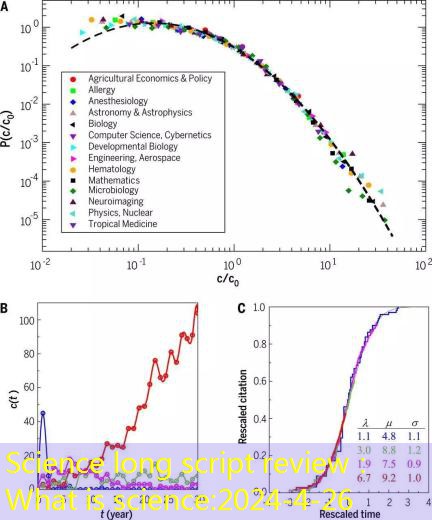
Figure 5 The generality of the citation dynamics
(A) If the number of references of each paper C Except for the average number of references of all the papers of the subject C0, then the reference distribution of papers published in the same discipline and year, each discipline is basically uniform.The dotted line is a normal -state fitting curve.(69)
(B) The history of the four papers published in the four papers published in the “Physical Review” in 1964, according to its unique dynamic choices, showed the “jump decay” mode (blue), peak delay (purple red), number of citations quantityStable mode (green), and the citation index rose (red).(C. Single paper) Citation is determined by three parameters: Fitness λ, Immedial μ, and Longevity σ.Through appropriate (λ, μ, σ) parameters, the references of each paper in each paper in each paper are merged into a general function, which is the same for all disciplines.(77)
The distributed tail information can capture the number of high -influential papers and reveal the accumulated mechanism of the number of drivers.Recent analysis shows that it follows the distribution of power law (71-73).The tail of the power of the power can be generated by the process of accumulating advantages (74), and the network science refers to it as the preference attachment (75), indicating that the probability of referenced thesis increases with the number of references it has accumulated.
Such a model can enhance the model explanation with other characteristics of reference dynamics, such as outdated use of knowledge.The quantity of the article decreases (76, 79, 106) over time, or it can also use a fitting parameter (Fitness Parameter) to be attractive to the scientific community (77,78) for each paper.Only a small part of the papers cannot be described by the above assumptions, called “Sleeping Beauty”, because they are unattended for a while after the publication, but after a period of time, they suddenly receive a lot of attention and citations (80, 80, 80, 80, 80, 80, 80,, 80, 80.81).
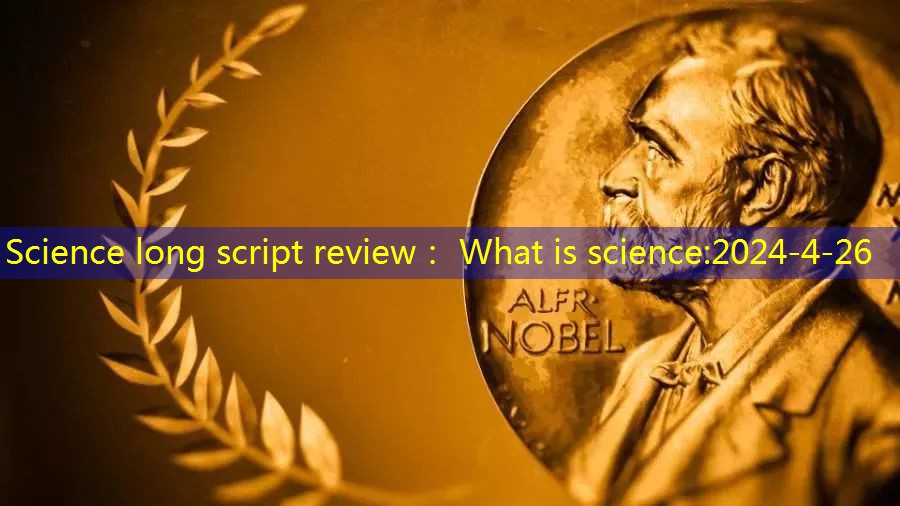
The above -mentioned formation mechanism can be used to predict the reference dynamics of a single paper.The probability of a prediction model (77) assumes the cither of the paper depends on the number of previous references, and considers the outdated factor of each article and the adaptive parameter (Figure 5, B, C) to predict thisNumber of references of the article.It can be inferred that the long -term impact of a certain scientific research work (77).Other studies have determined prediction indicators related to the influence factor (82), such as periodical impact factor (72).Some studies indicate that a scientist’s H-Index (83) can be accurately predicted (84).Although the accumulation of scientists and the accumulation of the H-Index is considered, the non-decreasingness will be reduced (85).
Behind the inconsistency of using quantitative assessment indicators in science and the common statistical data, the internal mechanism of generating these data is a very important mechanism in scientific research.
8. Outlook
Although scientific research does have its universality, the background differences in the substantive disciplines of culture, habits, and preferences make it difficult to understand certain cross -domain insights in some fields, and it is difficult to implement the corresponding policies.The differences in the problems, data and skills required by each discipline show that further insights can be obtained from scientific research in specific fields.These studies simulation and predicts meet the needs and opportunities in each subject field.For young scientists, the results of scientific research provide effective insights in scientific research in the past, helping to guide them to foresee future foresees (BOX1).
BOX1: Lessons to us scientifically
Innovation and tradition: Pure, true innovation and high -disciplinary ideas may not be able to achieve the scientific influence they can achieve.In order to enhance its influence, new ideas should be placed under the existing discipline environment (26).
Persistence: As long as you keep studying, there will never be “too old” in the concept of scientists (49).
Cooperation: Now the research model is moving towards the team, so participation in collaboration is greatly beneficial.The work of small teams is often more disruptive, and those strong teams often have greater resources to do more influential work (4,50,53).
Reputation: Most reputation will belong to the co -author of the same job in the field of literature (62).
Fund: Although the review team promises to support innovation, they are actually more inclined to ignore innovation.The funding institutions should request the reviewer to evaluate and innovate, not just the success predicted in their minds (24).
The contribution of science is to make a detailed understanding of the relationship between the relationship between scientists, institutions, and ideas. This is the key starting point for identifying the operating mechanism behind it.In short, these data-driven (Data-Driven) work supplements the lack of related research areas, such as economics (30) and scientific sociology (60,86).
Causal Estimation is a typical example of economics. The Economics Research Association collected and used comprehensive data sources to simulate the required simulation (31,42).Evaluating causal relationship is one of the most needed future development in science: many descriptive studies reveal the strong correlation between the scientific research structure and the success of the success, but the degree of “caused” results of the specific structure has not been explored -we do not knowCause and effect behind correlation.
By establishing a closer cooperative relationship with researchers, science will be able to better identify the connection found from models and large -scale data. These data have the potential to promote the birth of relevant policies.However, the experiment of science may be the biggest challenge that science has not faced.Range random control tests will change the research process of individuals or scientific institutions supported by taxes. Such high costs will inevitably cause criticism and obstacles (87).
Therefore, in the near future, the quasi-EXPERIMENTAL Approaches will dominate the scientific survey.
Most scientific research uses scientific research literature as the main data source, which means that the research objects of this discipline thinking and discovery are those successful cases.However, most scientific research has failed, and sometimes even a huge failure.In view of the number of times the failure of scientists is more than success and failure, it is essential for understanding and where, why, and how to fail to understand and improve the scientific system.These studies can provide meaningful guidance for the reproducible crisis and help us solve the file drawer problem.By revealing creative activities, these studies can also greatly promote the interpretation of human creativity.
The scientific system and economic system are similar. It is an economic system that uses one -dimensional “currency” citation.This implies that the class also exists in the scientific research system. Among them, the “rich people get richer” suppress the spread of new ideas, especially those new scientists and those who do not meet the traditional identity of specific fields.
The scientific system can be improved by expanding the number and scope of performance indicators.In this regard, formulating the alternative indicators of the Metrics Covering Web (88), social media (89) activity and social impact (90) are formulated.Other measured dimensions also include information (such as data) (91) shared by scientists and competitors, as well as the help they provide to their peers (92), and the reliability of their reviewers as colleagues (93).
However, because a large number of indicators are required, more work is required to understand the role of each indicator and the content that is not captured to ensure meaningful explanation and avoid abuse.Science can make various contributions by providing models. These models can more deeply understand the coverage of scientific performance indicators and the mechanism behind them.For example, the experience model observed when using alternative indicators (for example, distribution of literature download) will enable us to explore the relationship between them (94) between the quantity -based measurement system and identify the dark box operation.
The combination of indicators based on referenced quantities and other indicators will promote the diversified development of scientific research and realize the division of labor of scientific research productivity. This scientist can achieve achievements in different ways.Science is an ecosystem that requires not only publishing, but also experts, teachers, and experts who pay attention to details.We need to be able to raise questions about novel, change innovation, and people who can answer questions.If curiosity, creativity, and knowledge can be effectively communicated -especially information about the application of science and technology and social impact -more diversified methods can reduce duplication, and science can flourish (95).
One problem that science tries to solve is the distribution of scientific funds.The current peer review system has prejudice and contradictions (96).Several alternative plans have been proposed, such as random distribution funds (97), which does not involve the fund -oriented fund (31) that does not involve the proposal and review system to open to the online crowd (98).Review mechanism (99) and scientists crowdfunding (100) funds.
A key area of the future research of Science (Science) is to integrate with machine learning and artificial intelligence, allowing objective machines to work with humans.These new tools will have a pleasant profound, because machines may broaden the horizon of scientists than human collaborators.For example, self -driving vehicles are machine learning technology, which is a successful combination of human -known driving technology and unknown driving habits.The research of mental -machine partnership provides a wide range of positive effects in decisions in the fields of hygiene, economy, society, and law (101-103).How to improve science through the relationship between machines and spiritual soul, and how to arrange science development more effective?These issues help us understand future science.
references
1. E. Garfield, Citation Indexes for Science; A New Dimension in Documentation Through Association of Ideas. Science 122, 108–111 (1955). Doi: 10.1126/Science.122. 3159.108;
PMID: 14385826
2. D. J. S. Price, Little Science, Big Science (Columbia Univ. Press, 1963).
3. J. G. FOSTER, A. RZHetsky, J. A. Evans, Trading and Innovation in Scientis ’Research Strategies. Am. Sociol. Rev. 80, –908 (2015).
0003122415601618
4. S. Milojević, Quantifying The Cognitive Extent of Science.
5. T. KUHN, M. Perc, D. Helbing, Inheritance Patterns in Citation Networks Reveal Scientific Memes. Phys. Rev. X 4, 041036 (2014). Doi: 10.1103/PHYSREVX.04110 36
6. R. Klavans, K. W. Boyack, Which Type of Citation Analysis Generates The Most Accurate Taxonomy of Scientific and Technical Knowledge? echnol. 68, 984–998 (2016). Doi: 10.1002/ASI.23734
7. U. Shwed, P. S. Bearman, The Temporal Structure of Scientific Consensus Formation. AM. Sociol. Rev. 75, 817–840 (2010). Doi: 10.1177/0003122410388488; ID: 21886269
8. J. Bruggeman, V. A. Traag, J. UITERMARK, Detecting Commities Through Network Data. Am. Sociol. Rev. 77, 1050–1063 (2012). Doi: 10.1177/00031224124635777 4
9. F. Shi, J. G. Foster, J. A. Evans, weaving the fabric of science:
Dynamic Network Models of Science ’s Unfolding Structure. Soc. Networks 43, 73–85 (2015). Doi: 10.1016/J.Socnet.2015.02.006
10. L. M. A. Bettencourt, D. I. KAiser, J. Kaur, Scientific Discovery and Topology Transitions in Collaboration Networks. J. Informedr. D Oi: 10.1016/
j.joi.2009.03.001
11. X. Sun, J. Kaur, S. Milojević, A. Flammini, F. Menczer, Social Dynamics of Science. Sci. 3, 1069 (2013). Doi: 10.1038/SREP01069; PMID: 23323221212
12. T. S. KUHN, The Essential Tension: SELECTD Studies in Scientific Tradition and Change (Univ. Of Chicago Press, 1977).
13. P. Bourdieu, The Specificity of the Scientific Field and the Social Conditions of the Progress of Reason. SCI. (PARIS). Doi: 10. 10. 1177/
053901847501400602
14. T. JIA, D. Wang, B. K. Szymanski, Quantifying Patterns of Research-Interest Evolution. Nat. Hum. 1hav. 1, 0078 (2017) .Doi: 10.1038/S41562-017-0078
15. A. RZHETSky, J. G. FOSTER, I. T. T. Foster, J. A. Evans, Choosing Experiments to Accelerate Collection Discovery. ProC. Natl. Sci.a.a. 112, 14569–14574 (2014569–14574 (2014569–14574 5).
Doi: 10.1073/PNAS.1509757112; PMID: 26554009
16.
17. S. B. Nissen, T. Magidson, K. GROSS, C. T. BergStrom, Publication Bias and the Canization of False Facts. Elife 5, E21451 (2016). Doi: 10.7554/ELIFE.21451 ; PMID: 27995896
18. L. Yao, Y. Li, S. Ghosh, J. A. Evans, A. RZHETSky, Health Roi as a Measure of Misalignment of Biometal Needs and Resources. Nat. – 811 (2015). Doi: 10.1038/nbt.3276; PMID: 26252133
19. C. S. Wagner et al., APPROACHES to UndersTnding and Measuring International (2011). Doi: 10.1016/j.joi.2010.06.004
20. V. Larivière, S. Haustein, K. Börner, Long-Distance Interdisciplinarity Leads to Higher Scientific IMPACT. Plos One 10, E0122565 (2015). Doi: 10.1371/Journal .pone.0122565; PMID: 25822658
21. K. J. Boudreau, E. C. Guinan, K. R. Lakhani, C. RIEDL, LOOOKING ACROSS and Looking Beyond The Unitedory Frontier:
Intellectual distance, Novelty, and Resource Alocation in Science. Manage. Sci. 62, 2765–2783 (2016). Doi: 10.1287/mnsc.2015.2285; PMID: 27746512
22. E. Leahey, J. Moody, Sociology Innovation Through Subfield
Integration. SoC. Currents 1, 228–256 (2014). Doi: 10.1177/2329496514540131
23. A. Yegros-Yegros, I. RAFOLS, P. D ’EST
Research Lead to God Citation Impact? The Different Effect of Proximal and Distally Interdisciplinarity. Plos One 10, E0135095 (2015). Doi: 10.1371/Journal.p One.0135095; pmid: 26266805
24. L. Bromham, R. Dinnage, X. HUA, Interdisciplinary Research has consistently lowEESS. Nature 534, 684–687 (2016). Doi: 10.1038/Nature18315; PMI D: 27357795
25. D. Kim, D. B. Cerigo, H. Jeong, H. Youn, Technological Profile and Inventions Future Impact. Epj Data sci. 5, 8 (2016). Doi: 10.1140/Epjds/S136888888 -016-0069-1
26. B. Uzzi, S. Mukherjee, M. STRinger, B. Jones, Atypical Combinings and Scientific IMPACT. Science 342, 468–472 (2013). Doi: 10.1126/Science.1240474; PMI D: 24159044
27. J. Wang, R. Veuglers, P. Stepha, “Bias Against Novelty in Science: A Cautionary Tales of Bibliometric Indicators” (NBER Working Paper No. 22180, National Bu Reau of Economic Research, 2016).
28. J. P. Walsh, Y.-N. Lee, The BureaUcratization of Science. Res. Policy 44, 1584–1600 (2015). Doi: 10.1016/J.Respol.2015.04.0101010101010101010101010A
29. A. M. Petersn, M. Riccaboni, H. E. Stanley, F. Pammolli, Persistence and UNCERTAINTY in the Academic Career.proc. Natl. Sci.a.a. 109, 5213–5218 ). Doi: 10.1073/PNAS.1121429109;PMID: 22431620
30. P. E. Stephan, How Economics Shapes Science (Harvard Univ.
Press, 2012).
31. P. Azoulay, J. S. Graff Zivin, G. Manso, Incentives and creativity: Evidence from the academic life sciences. Rand J. Econ. 42, 527–554 (2011). doi: 10.1111/
j.1756-2171.2011.00140.x
32. R. Freeman, E. Weinstein, E. Marincola, J. Rosenbaum, F. Solomon, Competition and Careers in Biosciences. Science
294, 2293–2294 (2001). Doi: 10.1126/Science.1067477; PMID: 11743184
33.
34. V. Larivière, C. Ni, Y. Gingras, B. Cronin, C. R. Sugimoto, Bibliometrics: Global Genetric Disparits in Science 504, 211–213 (2013). Doi: 10.1038/5042 11A;
PMID: 24350369
35. S. F. Way, D. B. Larremore, A. Clauset, in Proceedings of the 25th International Conference on World Wide Web (www ’16) (ACM, 2016), PP. 1169–1179.
36. J. Duch Et Al., The Possible Role of Resource Requirements and Academic Career-Choice Risk On Gender Differentes in Publication Rate and IMPACT. Plos One 7, E5 1332 (2012). Doi: 10.1371/Journal.pone.0051332; PMID: 23251502
37. J. D. West, J. Jacquet, M. M. King, S. J. Correll, C. T. Bergstrom, The Role of Genery Authorship. Plos One 8, E66212 (2013). Doi: 10.1371/Journal.pone .0066212; PMID: 23894278
38. X. H. T. Zeng et al., Differences in Collaboration Patterns Across Discipline, Career Stage, and Gender. Plos Biol. 14, E1002573 (2016). Doi: 10.1371/Journal. pbio.1002573; pmid: 27814355
39. T. J. Ley, B. H. Hamilton, The Genera Gap in Nih Grant Application. Science 322, 1472–1474 (2008). Doi: 10.1126/ science.1165878888; PMID: 19056961
40. C. A. Moss-Racusin, J. F. Dovidio, V. L. Brescoll, M. J. Graham, J. Handelsman, Science Faculty ’s Subiter Biase STUDENTS. Proc. Natl. ACAD. SCI. U.S.A. 109, 16474–16479
(2012). Doi: 10.1073/PNAS.1211286109; PMID: 22988126
41. R. Van Noorden, Global Mobileity: Science on the Move. Nature 490, 326–329 (2012). Doi: 10.1038/490326a; PMID: 23075963
42. O. A. Doria Arrieta, F. Pammolli, A. M. Petersen, Quantifying
The Negative Impact of Brain Drain on the Integration of EUROPEAN Science. SCI. Adv. 3, E1602232 (2017). Doi: 10.1126/
sciadv.1602232; PMID: 28439544
43. C. Franzoni, G. Scellato, P. Stephan, The Mover ’s Advantage: The Superior Performance of Migrant Scientist. Econom. Lett. 122, 89–93 (2014). Doi: 10.1016/J.ECONLET. 2013.10.040
44. C. R. Sugimoto et al., Scientist has been impact when they ’re free to move. Nature 550, 29–31 (2017). Doi: 10.1038/550029a; 289806633
45. A. Clauset, S. ARBESMAN, D. B. Larremore, Systematic Inequility and Hierarchy in Faculty Hiring Networks. Sci. Adv.1, E1400005 (2015). Doi: 10.1126/sCIADV.1 400005; PMID: 266011125
46. P. Deville et al., Career on the Move: Geogram, Stratification, and Scientific Impact. Sci. 4, 4770 (2014). PMID: 24759743
47. A. M. Petersen et al., Reputation and IMPACT in Academic Careers. PROC. Natl. Acad. SCI. U.S.A. 111, 15316–15321 (2014). Doi: 10.1073/PNAS.1323111111; P MID: 25288774
48. D. K. Simonton, Creative productivity: A predictive and explanatory model of career trajectories and landmarks. Psychol. Rev. 104, 66–89 (1997). doi: 10.1037/
0033-295x.104.1.66
49. R. Sinatra, D. Wang, P. Deville, C. Song, A.-L. Barabási, Quantifying The Evolution of Individual IMPACT. Science 354, AAF5239 (2016). Doi: 10.11212 6/science.aaf5239; PMID: 27811240
50. S. WUCHTY, B. F. JONES, B. Uzzi, The Increasing Dominance of Teams in Production of Knowledge. Science 316, 1036–1039 (2007). Doi: 10.1126/Science.11360999999 ; PMID: 17431139
51. N. J. COOKE, M. L. Hilton, EDS., Enhancing the Effectiveness of Team Science (National Academies Press, 2015).
52. V. Larivière, Y. Gingras, C. R. Sugimoto, A. Tsou, Team Size Matters: Collaboration and Scientific Impact Since 1900. J. Assoc. Inf. Sci. Technol. 66, 1323 – 1332 (2015).
Doi: 10.1002/ASI.23266
53. L. Wu, D. Wang, J. A. Evans, Large Teams Have Developed Science and Technology; 7 SEPTEMBER 2017).
54. B. F. JONES, The Burden of Knowledge and the “Deth of the Renaissance Man”: Is Innovation Getting Harder? Rev. Econom. 76, 283–317 (2009). Doi: 10.1111/J.1 467-937x.2008.00531.x
55. S. Milojevi, Principles of Scientific Research Team Formation and Evolution. Proc. Natl. Acad. SCI. U.S.A. 111, 3984–3989 (2014). Doi: 10.1073/PNAS.130 9723111; PMID: 24591626
56. G. Palla, A.-L. Barabási, T. VICSEK, Quantifying Social Group Evolution. Nature 446, 664–667 (2007). Doi: 10.1038/Nature05670; PMID: 174101755555670; 1741017555555675
57. G. J. Borjas, K. B. Dara, Which Peers Matter? The Relative Impacts of Collaboators, Colleagues, and Competitors. Rev. Econom. 97, 1104–1117. Doi: 10.1 162/REST_A_00472
58. P. AZOULAY, J. G. Zivin, J. WANG, Superstar Extinction. Q. J. Econ. 125, 549–589 (2010). Doi: 10.1162/qjec.2010.125.2.549
59. A. M. Petersen, Quantifying the impact of weak, strong, and super ties in scientific careers. Proc. Natl. Acad. Sci. U.S.A. 112, E4671–E4680 (2015). doi: 10.1073/pnas.1501444112; pmid: 26261301
60. R. K. Merton, The Matthew Effect in Science. Science 159, 56–63 (1968). Doi: 10.1126/Science.159.3810.56
61. L. Allen, J. Scott, A. Brand, M. Hlava, M. Altman, Publishing: Credit where credit is due. Nature 508, 312–313 (2014). doi: 10.1038/508312a; pmid: 24745070
62. H.-W. Shen, A.-L. Barabási, Collective Credit Allocation in Science. Proc. Natl. Sci. U.S.A. 111, 12325–12330 (2014). Doi: 10.1073/PNAS.14019921111 1; PMID:25114238
63. L. Waltman, A Review of the Literator on City IMPACT Indicators. J. Informetr. 10, 365–391 (2016). Doi: 10.1016/J.JOI.2016.02.0077
64. J. E. Hirsch, An Index to Quantify An Individual ’s Scientific
Research output. PROC. Natl. ACAD. Sci. U.S.A. 102, 16569–16572 (2005). Doi: 10.1073/PNAS.0507655102; PMID: 162759155
65. H. F. Moed, CITATION Analysis in Research Evaluation (Springer, 2010).
66. E. Garfield, City Analysis as a Tool in Journal Evaluation.
Science 178, 471–479 (1972). Doi: 10.1126/science.178.4060.471; PMID: 5079701
67. D. J. De Solla Price, Networks of Scientific Papers. Science
149, 510–515 (1965). Doi: 10.1126/science.149.3683.510; PMID: 14325149
68. q. zhang, n. Perra, B. Gonçalves, F. Ciulla, A. Vespignani,
Characterizing Scientific Production and Consumption in Physics. Sci. Rep. 3, 1640 (2013). Doi: 10.1038/SREP01640; PMID: 2357132020
69. F. Radicchi, S. Fortunato, C. Castellano, Universality of Citation Distanceos: Toward An ObjectIVE Measure of Scientific Impact. Natl. SCAD. SCI. U.S.A. 105,
17268–17272 (2008). Doi: 10.1073/PNAS.0806977105;
PMID: 18978030
70. L. Waltman, N. J. Van Eck, A. F. J. Van Raan, Universality of Citation Distanceos Revisite. J. Assoc. Inf. Sci. 63, 72–77 (2012). DOI: 10.1002/ASI .21671
71. M. GOLOSOVSS, S. Solomon, Runaway Events Dominate the Heavy Tail of City Distributions. Eur. Phys. J. SPEC. Top. 205, 303–311 (2012). Doi: 10.1140/Epjst/Epjst/EPJST/EPJST/E 2012-01576-4
72. C. Stegehuis, N. Litvak, L. Waltman, Predicting The Long-Term Citation IMPACT of Recent Publications. J. Informetr. 9, 642–657 (2015). Doi: 10.1016/J.JOI.2 015.06.005
73. M. TheLwall, The DiscretISED LOGNORMAL and HOOKED POWER LAW DISTRIBUTIONS for Complete City Data: Best Options for Modelling and Regression. 10, 33 6–346 (2016). Doi: 10.1016/J.JOI.2015.12.007
74. D. DE Solla Price, a general theory of bibliometric and Other Cumulative advantage processes. 630270505
75. A.-L. Barabási, R. Albert, Emergeence of Scaling in Random Networks. Science 286, 509–512 (1999). Doi: 10.1126/science.286.5439.509
76. P. D. B. Parolo et al., Attention decay in science.
77. D. Wang, C. Song, A.-L. Barabási, Quantifying Long-Term Scientific Impact. Science 342, 127–132 (2013). Doi: 10.1126/science.1237825; PMID: 2409274555
78. Y.-H. EOM, S. Fortunato, Characterizing and Modeling Citation Dynamics. Plos One 6, E24926 (2011). Doi: 10.1371/Journal.0024926; PMID: 2196638777
79. M. Golosovsky, S. Solomon, Stochastic Dynamical Model of A Growing Citation Network Based on a Self-EXCITING PROINT PROINT PRYS. Rev. Lett. 109, 2012 . Doi: 10.1103/Physrevlett.109.098701; PMID:23002894
80.
81. Q. Ke, E. Ferrara, F. Radicchi, A. Flammini, Defining and and
Identifying Sleeping Beauties in Science. Proc. Natl. Acad. Sci. U.S.A. 112, 7426–7431 (2015). Doi: 10.1073/PNAS.1424329112; PMID: 2601555633
82. I. TAHAMTAN, A. SafiPour Afshar, K. Ahamdzadeh, Factors AFFECTING NUMBER of Citations: A Comprehensive Review of the Literator. 5 (2016). Doi: 10.1007/S11192-016-1889-2
83. 40045
84. D. E. ACUNA, S. Allesina, K. P. Kording, Future Impact: Predicting Scientific Success. Nature 489, 201-202 (2012). Doi: 10.1038/489201a; PMID: 22972278888888
85. O. Penner, R. K. Pan, A. M. Petersen, K. Kaski, S. Fortunato, on the Predictability of Future Impact in Science. Sci. 3, 3052 (2013). Doi: 10.1038/srep03030 52; PMID: 24165898
86. J. R. Cole, H. Zuckerman, in The Idea of Social Structure: Papers in Honor of Robert K. Merton, L. A. Coser, Ed. (Harcourt Brace Jovanovich, 1975), pp. 139–174.
87. P. Azolay, Research Efficience: Turn the Scientific Method On
OURSELVES. Nature 484, 31–32 (2012). Doi: 10.1038/484031A;
PMID: 22481340
88. M. TheLwall, K. Kousha, Web Indicators for Research Evaluation. Part 1: Citations and Links to Academic Articles from the Web. PROF. Inf. 24, 587–606. D Oi: 10.3145/EPI.2015.sep.08
89. M. TheLwall, K. Kousha, Web Indicators for Research Evaluation. Part 2: Social Media metrics. PROF. Inf. 24, 607–620 (2015). Doi: 10.3145/EPI.2015.SEP .09
90. L. Bornmann, what is societal impact of research and how can it be assessed? A likeon. Adv. Inf. SCI. 64, 217–233 (2013).
91. C. Haeussler, L. Jiang, J. Thursby, M. Thursby, Specific and General Information Sharing among Competing Academic Researcher. Res. Policy 43, 465–475 (2014).. Doi: 10.1016/J.Respol.2013.08.017
92. A. OETTL, Sociology: Honour the Helpful. Nature 489, 496–497 (2012). Doi: 10.1038/489496a; PMID: 23018949
93. S. Ravindran, “Getting Credit for Peer Review,” Science, 8 February 2016; www.sciencemag.org/careers/2016/02/Getting- Credit-Peer- Review.
94. R. Costas, Z. ZaHedi, P. Wouters, Do “Altmetrics” Correlation with Citations? Extensive Comparison of Altmetric Indicators FRE Inmed Perspective. J. Assoc. Inf. Sci. Technol. 66, 2003–2019 (2015). Doi: 10.1002/ASI.23309
75. A.-L. Barabási, R. Albert, Emergeence of Scaling in Random Networks. Science 286, 509–512 (1999). Doi: 10.1126/science.286.5439.509
76. P. D. B. Parolo et al., Attention decay in science.
77. D. Wang, C. Song, A.-L. Barabási, Quantifying Long-Term Scientific Impact. Science 342, 127–132 (2013). Doi: 10.1126/science.1237825; PMID: 2409274555
78. Y.-H. EOM, S. Fortunato, Characterizing and Modeling Citation Dynamics. Plos One 6, E24926 (2011). Doi: 10.1371/Journal.0024926; PMID: 2196638777
79. M. Golosovsky, S. Solomon, Stochastic Dynamical Model of A Growing Citation Network Based on a Self-EXCITING PROINT PROINT PRYS. Rev. Lett. 109, 2012 . Doi: 10.1103/Physrevlett.109.098701; PMID:23002894
80.
81. Q. Ke, E. Ferrara, F. Radicchi, A. Flammini, Defining and Identifying Sleeping Beauties in Science. PROC. Natl. Sci. U.S.A. 112, 7426–7431. Doi. : 10.1073/pnas.1424329112; PMID: 26015563
82. I. TAHAMTAN, A. SafiPour Afshar, K. Ahamdzadeh, Factors AFFECTING NUMBER of Citations: A Comprehensive Review of the Literator. 5 (2016). Doi: 10.1007/S11192-016-1889-2
83. 40045
84. D. E. ACUNA, S. Allesina, K. P. Kording, Future Impact: Predicting Scientific Success. Nature 489, 201-202 (2012). Doi: 10.1038/489201a; PMID: 22972278888888
85. O. Penner, R. K. Pan, A. M. Petersen, K. Kaski, S. Fortunato, on the Predictability of Future Impact in Science. Sci. 3, 3052 (2013). Doi: 10.1038/srep03030 52;
PMID: 24165898
86. J. R. Cole, H. Zuckerman, in The Idea of Social Structure: Papers in Honor of Robert K. Merton, L. A. Coser, Ed. (Harcourt Brace Jovanovich, 1975), pp. 139–174.
87. P. Azolay, Research Efficience: Turn the Scientific Method on OURSELVES. Nature 484, 31–32 (2012). Doi: 10.1038/484031a; PMID: 22481340
88. M. TheLwall, K. Kousha, Web Indicators for Research Evaluation. Part 1: Citations and Links to Academic Articles from the Web. PROF. Inf. 24, 587–606. D Oi: 10.3145/EPI.2015.sep.08
89. M. TheLwall, K. Kousha, Web Indicators for Research Evaluation. Part 2: Social Media metrics. PROF. Inf. 24, 607–620 (2015). Doi: 10.3145/EPI.2015.SEP .09
90. L. Bornmann, what is societal impact of research and how can it be assessed? A likeon. Adv. Inf. SCI. 64, 217–233 (2013).
91. C. Haeussler, L. Jiang, J. Thursby, M. Thursby, Specific and General Information Sharing among Competing Academic Researcher. Res. Policy 43, 465–475 (2014).. Doi: 10.1016/J.Respol.2013.08.017
92. A. OETTL, Sociology: Honour the Helpful. Nature 489, 496–497 (2012). Doi: 10.1038/489496a; PMID: 23018949
93. S. Ravindran, “Getting Credit for Peer Review,” Science, 8
February 2016; www.sciencemag.org/careers/2016/02/
getting-credit-peer-review.
94. R. Costas, Z. ZaHedi, P. Wouters, Do “Altmetrics” Correlation with Citations? Extensive Comparison of Altmetric Indicators FRE Inmed Perspective. J. Assoc. Inf. Sci. Technol. 66, 2003–2019 (2015). Doi: 10.1002/ASI.23309
Compilation: Jizhi Club Translation Group
Source: science
Original Title: Science of Science
Original address:
https://sclence.sciencemag.org/content/359/6379/eaao0185
Original title: “Science Long Text: What is Science | Spring Festival Special”














